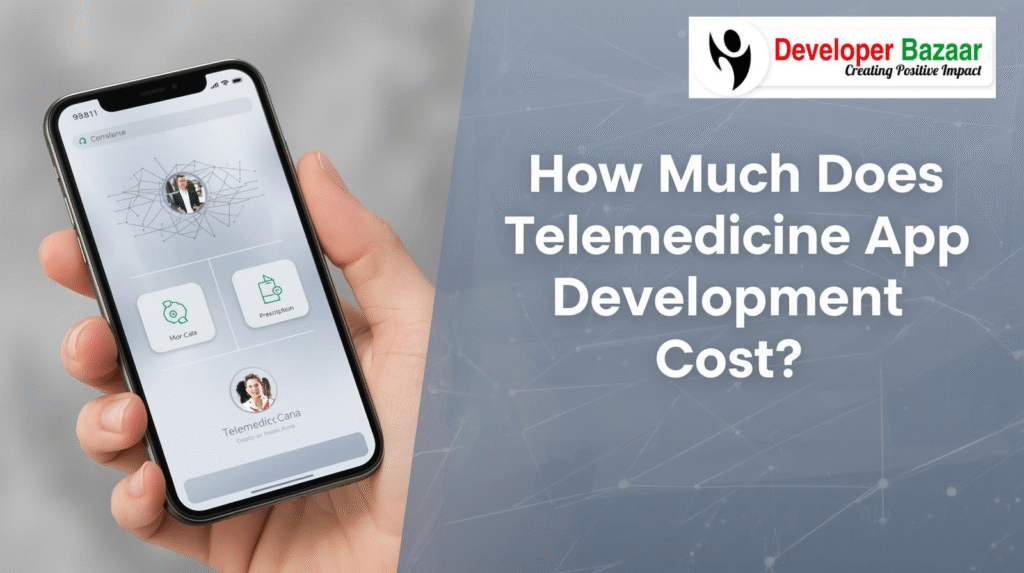
The healthcare industry has embraced digital transformation at a rate never seen before. Telemedicine applications have developed into essential tools for both patients and healthcare providers. However, the budget required to develop these applications remains a major challenge for healthcare companies.
The expenses related to the creation of telemedicine apps are broken down in this thorough overview. In order to assist you in making wise investing selections, we will examine a number of pricing-influencing elements.
Key Factors Affecting Telemedicine App Development Costs
The ultimate cost of your telemedicine application depends on a number of factors. Knowing these elements enables you to select the best development strategy and efficiently arrange your budget.
App Complexity Level
Development costs are significantly impacted by the intricacy of your telemedicine app:
- Basic Apps ($50,000 and $100,000) Basic telemedicine apps that cost between $50,000 and $100,000 include the ability to make video calls, schedule appointments, and keep simple patient data.
- Apps with a medium level of complexity ($100,000–200,000): Provide electronic health records, payment integration, and prescription management.
- Advanced business solutions (between $200,000 and $500,000+): Include IoT device integration, AI diagnostics, and thorough analytics
Platform Selection
Your choice of platforms significantly affects the overall budget:
- iOS Development: iOS development often costs 15–25% extra because of the App Store’s stringent regulations.
- Development of Android: Offers a wider market reach, but it needs to be tested on a variety of devices.
- Programs that run across platforms: Reduce costs by 30–40% without compromising cross-platform functionality.
- Programs that are web-based: Lower development costs while guaranteeing broad accessibility.
Essential Features and Functionality
Core features form the foundation of your telemedicine app’s cost structure:
- Video consultation capabilities with HD quality streaming
- Secure patient registration and profile management
- Systems for file sharing and real-time messaging
- Scheduling of appointments and calendar integration
- Payment processing and insurance verification
- Integration of electronic health records (EHRs)
- E-prescribing and prescription management
Development Team Structure and Costs
One of the most important factors influencing project expenses is the makeup of your development team. Depending on the needs of the project, a telemedicine app development company usually puts together specialist teams.
In-House Development Team
Building an internal team requires significant investment:
- Project Manager: $80,000 – $120,000 annually
- UI/UX Designers: $70,000 – $100,000 each
- Frontend Developers: $90,000 – $130,000 each
- Backend Developers: $100,000 – $140,000 each
- Quality Assurance Engineers: $60,000 – $90,000 each
Outsourced Development Options
Working with external telemedicine app development services offers cost-effective alternatives:
- North American agencies: $100 – $200 per hour
- Western European firms: $80 – $150 per hour
- Eastern European companies: $50 – $100 per hour
- Asian development teams: $25 – $75 per hour
Regional Cost Variations
Geographic location significantly impacts development costs. Top telemedicine app developers operate across different regions with varying price structures.
North America
- Expertise in regulatory compliance and the highest quality standards
- High-end cost that reflects cutting-edge technical capabilities
- Strong emphasis on data security and HIPAA compliance
- Project expenses typically fall between $150,000 and $400,000.
Europe
- Balanced approach between cost and quality
- GDPR compliance is given top priority.
- Teams with expertise in the healthcare domain
- Usually, project expenses fall between $100,000 and $300,000
Asia-Pacific
- Cost-effective development solutions
- Large talent pool with diverse skill sets
- Increasing proficiency in medical technologies
- Typically, projects cost between $50,000 and $200,000
Technology Stack Impact on Costs
The choice of technologies directly influences development expenses and long-term maintenance costs.
Frontend Technologies
Current frontend frameworks have an impact on development costs and speed:
- React Native: Allows for cross-platform development at a 30% cost reduction
- Flutter: Google’s framework offering native performance at reduced costs
- Native iOS/Android: Better performance but a larger initial investment
- Progressive Web Apps: The most economical choice with wide compatibility
Backend Infrastructure
Server-side technology decisions impact scalability and operational costs:
- Cloud platforms (AWS, Azure, Google Cloud): $500 – $2,000 monthly
- Database solutions: PostgreSQL, MongoDB, or specialized healthcare databases
- API development: RESTful or GraphQL implementations
- Third-party integrations: EHR systems, payment gateways, and medical devices
Regulatory Compliance and Security Costs
Strict adherence to regulatory norms is necessary for healthcare applications. Complete security measures must be incorporated into telemedicine app development solutions from the very beginning.
HIPAA Compliance Requirements
- Protocols for secure data transmission
- Encrypted storage systems
- Audit trail capabilities
- User authentication and authorization
- Agreements with Business Associates (BAAs)
Additional Security Measures
- Two-factor authentication implementation
- Regular security audits and penetration testing
- SSL certificate installation and maintenance
- Data backup and disaster recovery systems
- Compliance documentation and training
Ongoing Maintenance and Support Costs
Post-launch expenses account for a significant portion of your total investment. Plan for regular improvements and updates to remain competitive.
Annual Maintenance Budget
- Basic maintenance: 15-20% of initial development cost
- Feature updates: Additional 10-15% annually
- Security patches: Ongoing expense for compliance
- Server costs: Depending on the volume of users, monthly fees
- Third-party licenses: Software subscriptions and API fees
Long-term Investment Considerations
- Frequent OS compatibility and platform upgrades
- Emerging technology integration opportunities
- Scalability improvements as user base grows
- Updates to compliance and improved security measures
Conclusion
Depending on the telemedicine app’s features, level of complexity, and development process, the price can vary significantly. Compared to basic apps, which start at around $50,000, enterprise-grade solutions can cost over $500,000. The key is working with telemedicine app development firms that have experience and understand user needs and healthcare regulations.
To be successful in telemedicine, one needs to balance long-term value creation with short-term investment. As user feedback and market demands dictate, add more functionality after giving priority to the most crucial aspects. This plan efficiently ensures sustained growth while containing development costs.


